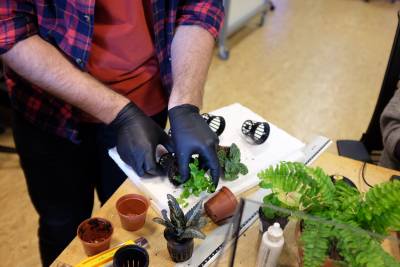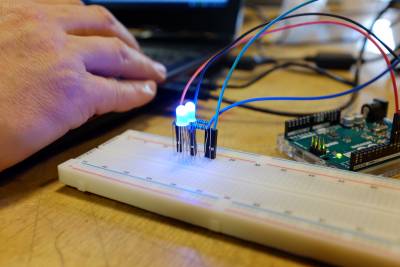Outils d'utilisateurs
Sidebar
Terrarium project (English version)
Fiche projet
An exchange project has been set up between Universcience and the Cluj Cultural Center in Romania, as part of the France-Romania season. The first part of this exchange consists of a FabLab residence of two Romanian Biologists from the University of Agricultural Sciences and Veterinary Medicine Cluj-Napoca, who, together with the Carrefour de Numerique team, will work on building up a fully automated terrarium. The residence runs from March 19th to 23rd.
Once the Terrarium is in place, the objective of the residence is to be able to check & register the parameters of soil & air humidity, air temperature & ventilation as well as the light-intake of the terrarium and to build up an automatized system for watering, heating/cooling, lighting and air flow in the terrarium.
The system will also be used to study different aspects of the Terrarium Eco-System. How do plants affect each other, what is the correlation between humidity, temperature and light intake, what are the optimal humidity, temperature and light values for a favorable plant growth?
The second step of the exchange project will be concerned with setting up a web application for controlling the Terrarium remotely. For example, when we go on vacation, we stop watering our plants and turn off the heat. The temperature dropping and the humidity decreasing over a longer period of time, could be dramatic for the plants. Controlling the terrarium remotely over the phone or computer could save a lot of plant lives!
Conception
Terrarium
To set up the terrarium technically, you will need :
- A terrarium > the box: can be found in any petshop or you can recycle an old aquarium, ours is a 40x25x25 cm (LxWxh) glass aquarium
- Clay balls > 1st layer: to cover the terrarium floor - used for draining the excess water from the soil - you can find them in bigger garden shops
- A piece of geotextile > 2nd layer: a felt-like non-woven textile to cover the clay balls and the vertical wall. - this tissue will keep the soil from mixing with the clay balls, depending on the texture the textile will absorbe the water and keep the soil wet for a longer time, you can alternatively use a mosquito net. > https://study.com/academy/lesson/what-is-geotextile-fabric-definition-types.html
- Soil > 3rd layer: Find a a kind of soil made from sphagnum moss. A soil with a little bit acidity (here PH 4.8) which encourages plants growth.
- Moss > 4th layer: to cover everything, used for aesthetics, you can also use dry leafs
- Plants > Choose dwarf plants, they won't grow too much (ask when you buy it). Examples : Fittonia sp, Syngonium sp, Pilea cadierei Sil, Nephrolepsis sp, Ficus pumila sp. Make sure to use humidity loving plants from the same biotope.
Electronic part
We chose to use an arduino uno to control:
- RGB lights: Red & Blue lights are helping plant growth, while the green light mimics the sun-light and makes the terrarium look pretty :)
- a computer fan: to enable air-flow and to balance the internal air-humidity
- an air humidity and temperature sensor > we used DHT 22
- a soil humidity sensor >
- a water pump > we used VMA421
Because there is a lot of files on this project, we continue the documentation and deposit on a framagit :
Deposit can be found here : https://framagit.org/makeforartandscience/terrarium
Wiki documentation is here : https://framagit.org/makeforartandscience/terrarium/wikis/home







